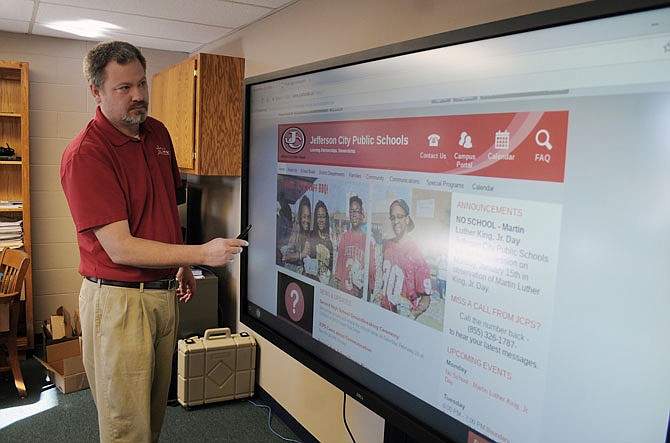Jefferson City Public Schools is considering replacing the smartboards in its high schools with interactive TVs to liberate teachers from the technological tethers that tie them to the front of classrooms; the move would also save money in maintenance costs.
Nothing's a done deal so far, but JCPS Chief of Learning Brian Shindorf and the district's technology department are looking into how feasible interactive TVs would be as replacements for smartboards, given the construction and renovation at the district's soon-to-be two high schools.
"(Workers renovating the current high school are) going to have to do a lot of removal of ceilings in the classrooms, and what they're saying is that they would have to remove the current projectors out of the existing high school in order to do the work that they need to do," Shindorf told the district's Board of Education this month.
The district is weighing the cost of putting those projectors back in compared to installing TVs instead and using the existing smartboards and projectors in JCPS' elementary schools until the technology is phased out, he said.
"The whole goal is to get unconnected," Shindorf said Friday, adding if the interactive TVs don't demonstrate the wireless capabilities the district hopes to give its teachers in the future, then they won't pursue replacing the current smartboard systems.
The current smartboard systems are interactive - and the TVs wouldn't do anything different in that regard - but the smartboards have physical limitations that come with cables and projectors.
The present set-ups in classrooms and other rooms across the district require teachers and staff to be at a device hooked up to a smartboard via cable or be standing at the board, Shindorf said.
With wireless connectivity, teachers wouldn't be tied to a device and could be at the back of a class looking forward, he added.
The district has been testing an interactive TV setup at its Dix Road facility to determine the effectiveness of its wireless capabilities - if the device really can let teachers interact with it from their Google Chromebooks on the other side of a classroom, for example.
"That's what we're hoping to get out of it," system engineer Scott Wood said Friday while standing in front of the TV, which is why he prefers the term "interactive" to describe the large-screen TVs over "smart."
By the start of next school year, Shindorf said, all students will be using Chromebooks, so there won't be any need to worry about connectivity with Apple iPads.
The TVs would be about as big as the one the district uses in its Board of Education room at meetings - wall-mounted, flatscreen LED sets with screens of about 70-75 inches.
Wood said each TV has a security code to control who can connect to it. When teachers, staff and students interact with them, the TVs themselves don't use any bandwidth on the district's wireless internet networks, he added.
There are some financial incentives to upgrading the technology despite the higher upfront cost of about $2,800 per interactive TV compared to about $2,000 for a projector and smartboard system.
For the district's nearly 1,000 projector systems, about 25 percent of their bulbs have to be replaced every year after an average lifespan of about 1,200-1,500 hours of use, audiovisual technician Adam Green said.
JCPS Director of Technology Joe Martin said bulbs cost $125-150 each to replace.
By transitioning completely from projectors and smartboards to interactive TVs, the district would stand to save about $31,250-37,500 a year.
Some teachers could test the TVs by February, Shindorf said. Then, depending on the results, he could take a proposal to the board by March.
He noted architects will need to know what course the district wants to take for classroom tech in its high schools so they will know where to install load-bearing structural elements and electrical components.
"We are building schools for the future, and we want to make sure the technology in it's going to meet those needs," he said.

